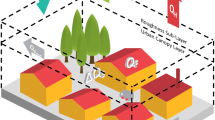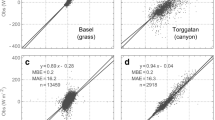Abstract
The parameterization of the energy balance from a residential and commercial neighborhood of Mexico City was investigated using direct measurements of radiative and heat fluxes carried out during the MILAGRO/MCMA-2006 field campaign as a reference. The measured fluxes were used to evaluate different models of the energy balance based on parameterizations that require standard meteorological observations: ambient temperature, relative humidity, atmospheric pressure and cloudiness. It was found that these models reproduce with reasonable accuracy the diurnal features of the radiative and heat fluxes. The largest differences between modeled and observed fluxes correspond to the incoming longwave radiation, mainly due to errors in the cloudiness data. This paper contributes to the understanding of the energy partitioning in (sub)tropical urban environments, particularly in the developing world, where energy balance models have not been evaluated.








Similar content being viewed by others
References
Anandakumar K (1999) A study on the partition of net radiation into heat fluxes on a dry asphalt surface. Atmos Environ 33:3911–3918
Barnard JC, Volkamer R, Kassianov EI (2008) Estimation of the mass absorption cross section of the organic carbon component of aerosols in the Mexico City Metropolitan Area. Atmos Chem Phys 8:6665–6679
Barradas VL, Tejeda-Martinez A, Jauregui E (1999) Energy balance measurements in a suburban vegetated area in Mexico City. Atmos Environ 22:4109–4113
Bond TC, Bergstrom RW (2006) Light absorption by carbonaceous particles: an investigative review. Aerosol Sci Technol 40(1):27–67
Brutsaert W (1975) On a derivable formula for long-wave radiation from clear skies. Water Resour Res 11:742–744
Camuffo D, Bernadi A (1982) An observational study of heat fluxes and their relationship with net radiation. Bound Lay Meteor 65:159–179
Crawford TM, Duchon CE (1999) An improved parameterization for estimating effective atmospheric emissivity for use in calculating daytime downwelling longwave radiation. J Appl Meteorol 38:474–480
Fast JD, de Foy B, Acevedo-Rosas F, Caetano E, Carmichael G, Emmons L, McKenna D, Mena M, Skamarock W, Tie X, Coulter RL, Barnard JC, Wiedinmyer C, Madronich S (2007) A meteorological overview of the MILAGRO field campaigns. Atmos Chem Phys 7:2233–2257
Grimmond CSB, Oke TR (1999a) Aerodynamic properties of urban areas derived from analysis of surface form. J Appl Meteorol 38:1262–1292
Grimmond CSB, Oke TR (1999b) Heat storage in urban areas: local-scale observations and evaluation of a simple model. J Appl Meteorol 38:922–940
Grimmond CSB, Oke TR (2002) Turbulent heat fluxes in urban areas: observations and a local-scale urban parameterization scheme (LUMPS). J Appl Meteorol 41:792–810
Holtslag AAM, Van Ulden AP (1983) A simple scheme for daytime estimates of the surface fluxes from routine weather data. J Clim Appl Meteorol 22:517–529
Hsieh CI, Katul G, Chi T (2000) An approximate analytical model for footprint estimation of scalar fluxes in thermally stratified atmospheric flows. Adv Water Resour 23:765–772
Idso SB (1981) A set of equations for full spectrum and 8 to 14 μm and 10.5 to 12.5 μm thermal radiation from cloudless skies. Water Resour Res 17:295–304
Jauregui E (1997) Heat island development in Mexico City. Atmos Environ 31:3821–3831
Jauregui E, Luyando E (1999) Global radiation attenuation by air pollution and its effects on the thermal climate in Mexico City. Int J Climatol 19:683–694
Kasten F, Czeplak G (1980) Solar and terrestrial radiation dependent on the amount and type of cloud. Sol Energy 24:177–189
Masson V (2000) A physically-based scheme for the urban energy balance in atmospheric models. Bound Lay Meteor 94:357–397
Masson V, Grimmond CSB, Oke TR (2002) Evaluation of the town energy balance (TEB) scheme with direct measurements from dry districts in two cities. J Appl Meteorol 41:1011–1026
Molina LT, Madronich S, Gaffney JS, Apel E, de Foy B, Fast J, Ferrare R, Herndon S, Jimenez JL, Lamb B, Osornio-Vargas AR, Russell P, Schauer JJ, Steve PS, Zavala M (2010) An overview of the MILAGRO 2006 campaign: Mexico City emissions and their transport and transformation. Atmos Chem Phys Discuss 10:7819–7983
Newton T, Oke TR, Grimmond CSB, Roth M (2007) The suburban energy balance in Miami, Florida. Geogr Ann 89A:331–347
Niemelä S, Räisänen P, Savijärvi H (2001a) Comparison of surface radiative flux parameterizations. Part I: longwave radiation. Atmos Res 58:1–18
Niemelä S, Räisänen P, Savijärvi H (2001b) Comparison of surface radiative flux parameterizations. Part II: shortwave radiation. Atmos Res 58:141–154
Offerle B, Grimmond CSB, Oke TR (2003) Parameterization of net all-wave radiation for urban areas. J Appl Meteorol 42:1157–1173
Offerle B, Jonsson P, Eliasson I, Grimmond CSB (2005) Urban modification of the surface energy balance in the West African Sahel: Ouagadougou, Burkina Faso. J Clim 18(19):3983–3995
Oke TR (1978) Boundary layer climates. Methuen & Co., London
Oke TR (1988) The urban energy balance. Prog Phys Geogr 12:471–508
Oke TR, Zeuner G, Jauregui E (1992) The surface energy balance in Mexico City. Atmos Environ 26B:433–444
Oke TR, Spronken-Smith RA, Jauregui E, Grimmond CSB (1999) The energy balance of central Mexico City during the dry season. Atmos Environ 33:3919–3930
Oleson KW, Bonan GB, Feddema J, Vertenstein M, Grimmond CSB (2008) An urban parameterization for a global climate model. Part I: formulation and evaluation for two cities. J App Meteor Climatol 47:1038–1060
Prata AJ (1996) A new long-wave formula for estimating downward clear-sky radiation at the surface. Quart J Roy Meteor Soc 122:1127–1151
Ramanathan V, Carmichael G (2008) Global and regional climate changes due to black carbon. Nature Geosciences 11:221–227
Roth M (2000) Review of atmospheric turbulence over cities. Quart J Roy Meteor Soc 126:941–990
Satterlund DR (1979) An improved equation for estimating long-wave radiation from the atmosphere. Water Resour Res 15:1649–1650
Steward I, Oke TR (2009). Newly developed thermal climate zones for defining and measuring urban heat island magnitude in the canopy layer. Eight Symposium on the Urban Environment. American Meteorological Society, Phoenix, Jan. 10–16
Swinbank WC (1963) Long-wave radiation from clear skies. Q J R Meteorol Soc 89:339–348
Tejeda-Martinez A, Jauregui E (2005) Surface energy balance measurements in the Mexico City region: a review. Atmosfera 18(1):1–23
van Ulden AP, Holtslag AAM (1985) Estimation of atmospheric boundary layer parameters for diffusion applications. J Clim Appl Meteorol 24:1196–1207
Velasco E, Pressley S, Grivicke R, Allwine E, Coons T, Foster W, Jobson BT, Westberg H, Ramos R, Hernández F, Molina LT, Lamb B (2009) Eddy covariance flux measurements of pollutant gases in urban Mexico City. Atmos Chem Phys 9:7325–7342
Whiteman CD, Zhong S, Bian X, Fast JD, Doran JC (2000) Boundary layer evolution and regional-scale diurnal circulations over the Mexico Basin and Mexican plateau. J Geophys Res 105:10081–10102
Acknowledgments
This study was supported by the National Science Foundation (ATM-0528227) and the Metropolitan Environmental Commission of Mexico. E. Velasco acknowledges the postdoctoral funding provided by the Faculty of Arts and Social Sciences of the National University of Singapore for the data analysis. The assistance and logistical support provided by the Atmospheric Monitoring System of the Federal District Government (SIMAT) was fundamental for the satisfactory development of this study. The cloudiness data were provided by J. Fast and J. Barnard from the Pacific Northwest National Laboratory and B. de Foy from Saint Louis University. The K↓ data used in the second evaluation of the modeling approach was provided by E. Alvarez from the National Meteorological Service. The authors acknowledge the comprehensive comments made by two anonymous reviewers that helped to improve substantially the original manuscript.
Author information
Authors and Affiliations
Corresponding author
Rights and permissions
About this article
Cite this article
Velasco, E., Pressley, S., Grivicke, R. et al. Energy balance in urban Mexico City: observation and parameterization during the MILAGRO/MCMA-2006 field campaign. Theor Appl Climatol 103, 501–517 (2011). https://doi.org/10.1007/s00704-010-0314-7
Received:
Accepted:
Published:
Issue Date:
DOI: https://doi.org/10.1007/s00704-010-0314-7




